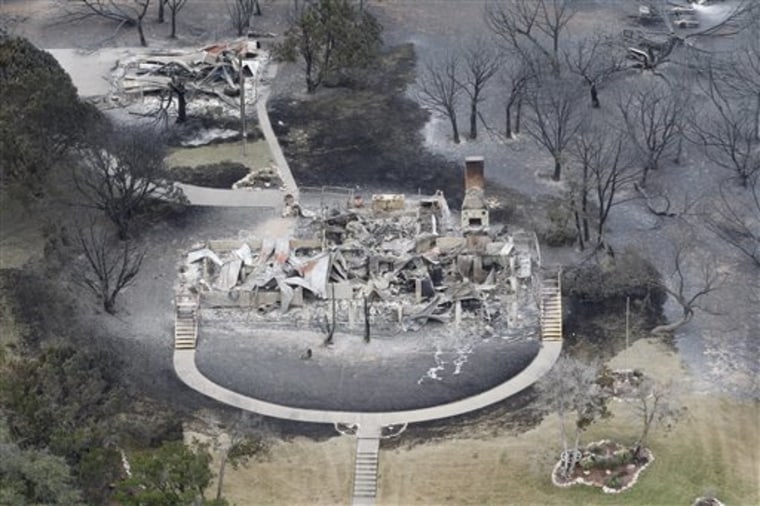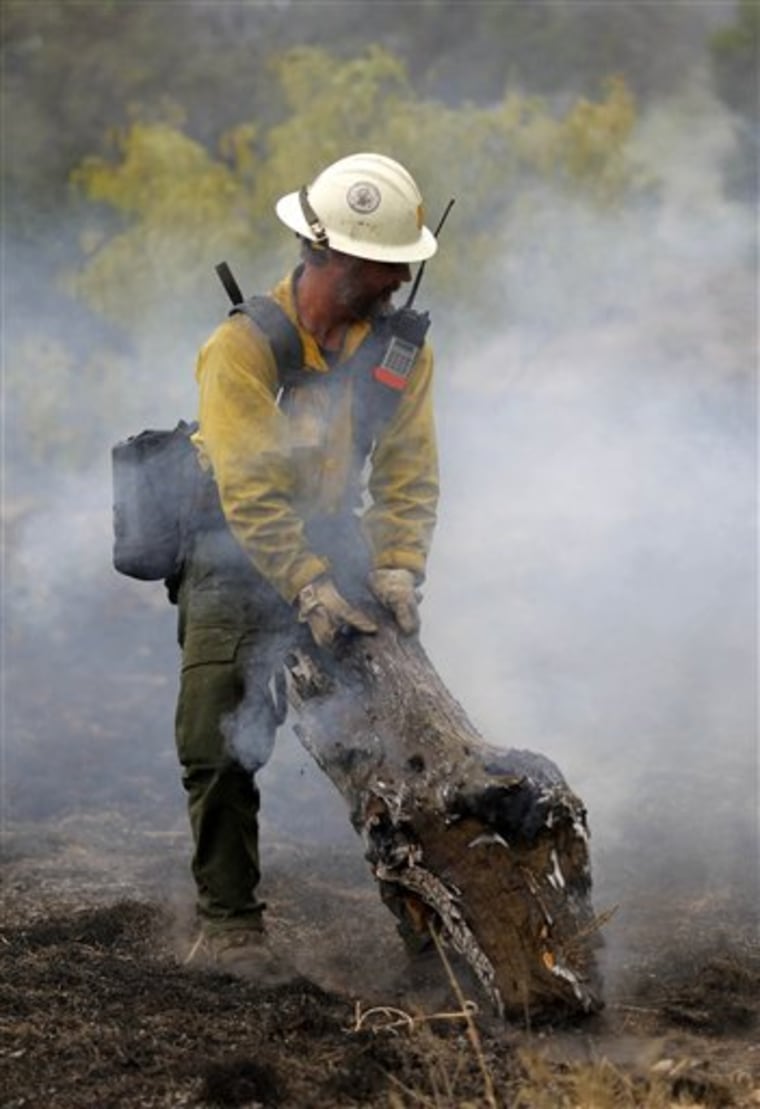A nighttime storm brought cooler temperatures, a bit of badly needed rain and a call for prayers from the Texas governor as firefighters west of Fort Worth continued battling one of several wild blazes in the state.
The rain, however, did little to ease a devastating drought charring pastures and drying out wheat fields across the Southwest and Plains states.
Texas Gov. Rick Perry has proclaimed a three-day period, from Friday to Sunday, as Days of Prayer for Rain in the state.
"Texans have been strengthened, assured and lifted up through prayer; it seems right and fitting that the people of Texas should join together in prayer to humbly seek an end to this devastating drought and these dangerous wildfires," Perry said in his proclamation. "I urge Texans of all faiths and traditions to offer prayers on that day for the healing of our land, the rebuilding of our communities and the restoration of our normal and robust way of life."
Any rain is welcome with nearly 70 percent of Texas in extreme and exceptional drought.
"We still have a lot of severe drought," said Mark Svoboda, climatologist with the National Drought Mitigation Center, which released its weekly drought analysis Thursday morning.
"Yeah there was a little bit of relief. But there has been a deficit of moisture for so long. Things are just not looking very good at all from Oklahoma down into Texas. That is the epicenter of this drought."
With a light drizzle falling on the Possum Kingdom Reservoir area about 70 miles west of Fort Worth, crews were trying to contain a week-old blaze that has blackened nearly 150 square miles of fields and woods and destroyed at least 160 homes of the community's 3,000 homes.
Haven Cook, a spokeswoman for the federal incident management team coordinating the Possum Kingdom firefight, said the overnight weather was damp enough in the nearby town of Mineral Wells that she had to use windshield wipers on her way into work Thursday morning.
"I've seen a nice steady drizzle," Cook said.
She said the fire was at 25 percent containment, but with the calmer conditions Thursday, teams hope to make progress in putting in more lines to stop the fire.
"They don't expect a lot of movement of the fire spread today," she said.
Ted Ryan, a National Weather Service meteorologist, said that while the storm system didn't bring significant rain to the affected area, it pushed overnight temperatures into the 50s and brought high humidity that would help the firefight. The forecast for the area called for a 20 to 30 percent chance of rain, winds of 10 to 15 mph and high temperatures in the 70s.
Wildfires, including several still burning, have scorched more than 1.4 million acres, or 2,100 square miles, in Texas since Jan. 1, according to the Texas Forest Service. More than 340 people, including firefighters from local departments and federal agencies and troops from the Texas Army National Guard, have battled the blaze that started in the Possum Kingdom Reservoir area.
The lower temperatures and overcast skies should help make trees and vegetation less flammable, said Matt Mosier, a weather service meteorologist based in Fort Worth. However, a prolonged period of precipitation and an end to the drought would be needed to end the wildfire threat, he said.
The improved weather conditions that rolled in Wednesday were expected to remain through the weekend, said David Boyd, spokesman for the federal incident management team coordinating the Possum Kingdom firefight.
"Right now, it looks like Monday before it's hot and windy again," he said.

"We still have a very long fires season ahead of us," Texas Forest Service spokesman Marq Webb said.
In West Texas, it was much the same story, with overnight storms in the area bringing cooler temperatures and higher humidity to help Thursday, but bringing little to no rain to the areas where the fires are still burning.
"The weather has really been cooperating," said Bridget Litten, a spokeswoman with the federal firefighting management team called in to help in the West Texas effort.
Of the largest fires in the area, she said the 160,000-acre Wildcat Fire in Coke County is at the stage where firefighters are just making sure nothing else pops up.
She said firefighters plan to cut a line Thursday in front of a fire near Fort Davis that has burned 202,000 acres and 40 structures. The fire is burning in a canyon, and the plan is to burn the area between the fire and the line to stop it.
Both fires are 75 percent contained.
She said that with the storms moving through the region there were a few small fires started by lightning, but she said crews knew that was a danger of storms when there are such dry conditions and were prepared.
Firefighting bill grows
Since Sept. 1, the beginning of the state's fiscal year, the Texas Forest Service owes $36.3 million for firefighting costs, according to Robby DeWitt, the agency's associate director for finance and administration. Of that, $23.8 million is due the federal government for air support, he said.
A team of federal firefighters and officials from several U.S. agencies — the second one to help with a Texas fire this month — joined local personnel Wednesday, this time to help fight the Possum Kingdom blaze.
Texas has been receiving federal help with West Texas wildfires for more than a week. Personnel from more than a half-dozen federal agencies — including the Forest Service, the National Park Service and the Bureau of Land Management — have been battling some massive fires, including a 150,000-acre fire in Coke County north of San Angelo.
"More of a federal effort is coming into the state now because of the severity of the fires and the number," Litten said.
Drought intensifies
Data issued Thursday by a consortium of national climate experts said 92 percent of Texas was suffering "severe drought," with 68 percent in the worse conditions of "extreme drought" or "exceptional drought." That is up from 60 percent a week ago in extreme and exceptional drought.
There was a slight alleviation of severe and extreme drought conditions in south-central to southeast Oklahoma and northeast Texas. But over much of the remaining region, drought conditions were maintained or even intensified.
Over the last week, the Oklahoma panhandle and parts of northern Texas, southeast Colorado, and southwest Kansas saw the introduction of extreme drought, according to the "Drought Monitor" report.
Rainfall is forecast over the next several days for parts of the Plains and into Texas, with perhaps 5 inches or more to fall in Oklahoma, according to forecasters.
Rain is badly needed for the maturing hard red winter wheat crop, a key bread-making crop and the largest class of U.S. wheat.
Cooler-than-normal temperatures in the Plains have also been helping preserve production potential for the wheat crop by slowing the crop's growth.
But with summer approaching, temperatures will be climbing, making wheat and other crops ever more thirsty.
"Going forward it only gets hotter," said Svoboda.
